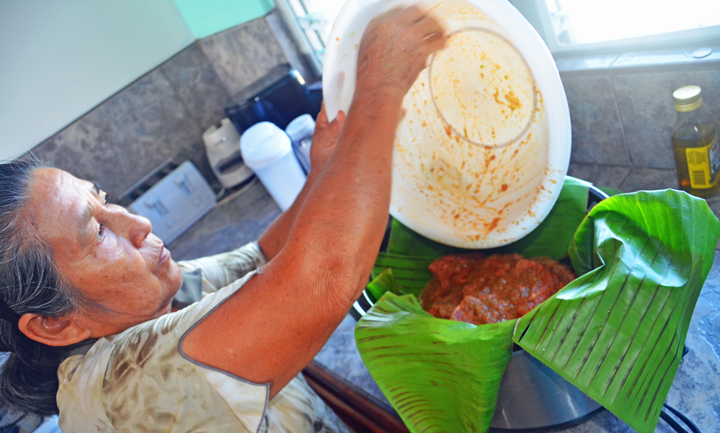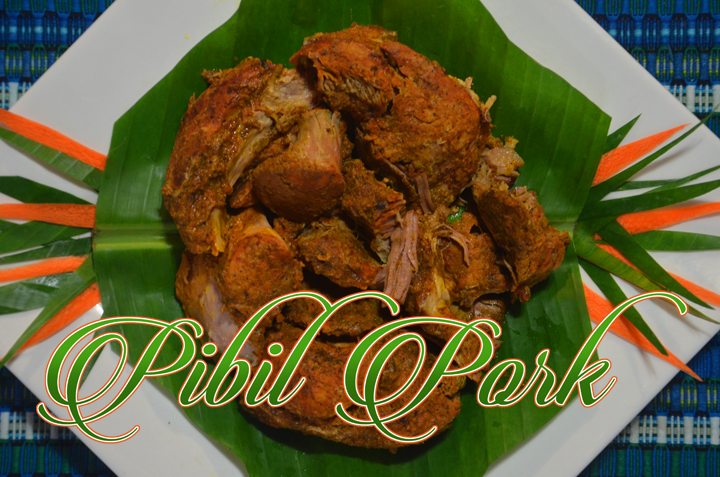Dommie's Pibil Pork
If you really want to have a traditional
pibil pork dish in Belize, it would be cooked in an underground pit like
a luau in Hawaii or a lovo in Fiji. The only difference I saw (or
actually was told) is that in Fiji you heat the rocks until they are hot
enough to cook your food. In Belize, you heat wood until the coal
embers are hot enough to cook the dish. Then, in both cases, the
contents are covered with banana leaves, buried under a pile of dirt,
and left alone to cook for three or four hours.
On Ambergris Caye, there actually wasn't an abundant supply of firewood for the traditional method. And, when I learned that my teacher, Dommie, preferred to prepare the dish in a crock pot, I had to go along with that convenience. Dommie, a neighbor of my sister, on occasion prepared traditional dishes for island visitors. I was delighted she was willing to teach me how to prepare pibil pork.
Dommie didn't abandoned all the traditions when she decided upon the crock pot. Either way, the meat was wrapped in banana leaves. Foil could be used, but I was promised that it tasted better when wrapped in banana leaves. Who was I to argue? Banana leaves were harvested from my sister's front yard.
Wash and rinse the banana leaves like any other green leafy vegetable you might buy (or harvest in your front yard). Then, the leaves have to be prepared. And, you kind of need a gas flame for this. You must heat the entire surface of the leaf with the flame. It's easy to see when you've done this because the color of the leaf turns a darker green. It doesn't take long at all to do this. The purpose of this heating is to make the leaf more flexible for wrapping the meat. Without heating, it would be just too brittle. Then, cut off the stem and place the sections of the leaves inside the crock pot. You want extra portions of the leaves hanging outside the pot because you will eventually fold them over the pork when it's ready to cook.
It's time to prepare the meat. You could use chicken, beef, or lamb, but it appears that pork is the traditional choice.
On Ambergris Caye, there actually wasn't an abundant supply of firewood for the traditional method. And, when I learned that my teacher, Dommie, preferred to prepare the dish in a crock pot, I had to go along with that convenience. Dommie, a neighbor of my sister, on occasion prepared traditional dishes for island visitors. I was delighted she was willing to teach me how to prepare pibil pork.
Dommie didn't abandoned all the traditions when she decided upon the crock pot. Either way, the meat was wrapped in banana leaves. Foil could be used, but I was promised that it tasted better when wrapped in banana leaves. Who was I to argue? Banana leaves were harvested from my sister's front yard.
Wash and rinse the banana leaves like any other green leafy vegetable you might buy (or harvest in your front yard). Then, the leaves have to be prepared. And, you kind of need a gas flame for this. You must heat the entire surface of the leaf with the flame. It's easy to see when you've done this because the color of the leaf turns a darker green. It doesn't take long at all to do this. The purpose of this heating is to make the leaf more flexible for wrapping the meat. Without heating, it would be just too brittle. Then, cut off the stem and place the sections of the leaves inside the crock pot. You want extra portions of the leaves hanging outside the pot because you will eventually fold them over the pork when it's ready to cook.
It's time to prepare the meat. You could use chicken, beef, or lamb, but it appears that pork is the traditional choice.

Dommie's
Pibil Pork
San Pedro, Ambergris Caye, Belize
San Pedro, Ambergris Caye, Belize
Ingredients:
Seasonings:
| 1 Tbs salt 1 Tbs garlic salt 1 Tbs onion salt 1 Tbs paprika |
1 Tbs annotte paste 1 diced onion 1 diced green bell pepper salt and pepper to taste |
First things first, you have to wash the pork in vinegar. Neither my sister nor I know why, but my sister says that Dommie washes almost all her meat in vinegar. At the same time, you need to examine your pork. If it is one big slab of pork, you'll need to poke holes in it for the seasoning. If your pork has slits, cracks, crevices, portions, division, nooks, and crannies for spices, you don't have to poke the pork. Once you have made your decision about the meat, cover both sides with the spices, mix it well into all crevices, and place it on top of the banana leaves in your crock pot.
The mystery ingredient in this recipe is the annotte paste. It's used in almost every local dish on the island. Dommie grew her own annotte and harvested the seeds each February. If you have not prepared well enough in advance to do this, you can purchase it in unmarked bags at most groceries. Everyone knows what it is without the need to read a label. It looks like a paste made from paprika. If you can't find any annotte, use paprika. Nobody outside of Central America will know you've made a terrible substitution.
Slice up your onion and bell pepper before tossing them in a blender with a little bit of water. Blend them up completely and then pour the mixture over the pork. Finally, wrap up the meat with the banana leaves. Okay, if you seriously don't have access to banana leaves, yes, you may use foil. You need to keep the moisture in the meat. You don't have to add any water. The pork has enough moisture.
Cook on high for one hour and then reduce the temperature to low for another two hours. It's ready when the meat is soft. Our pork was so tender it fell off the bone.
My sister served the pork with mashed potatoes and gravy made from the pork juices and coconut milk. To die for! And, I made another trip to the front yard for another banana leaf to garnish the dish. If you have access to banana leaves, it's kind of a requirement.
